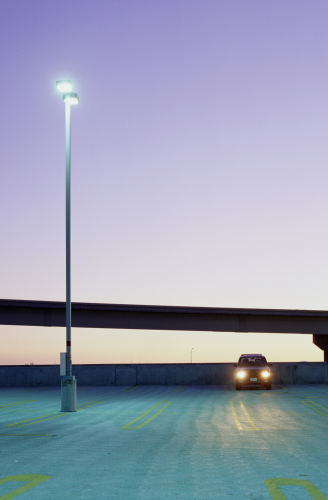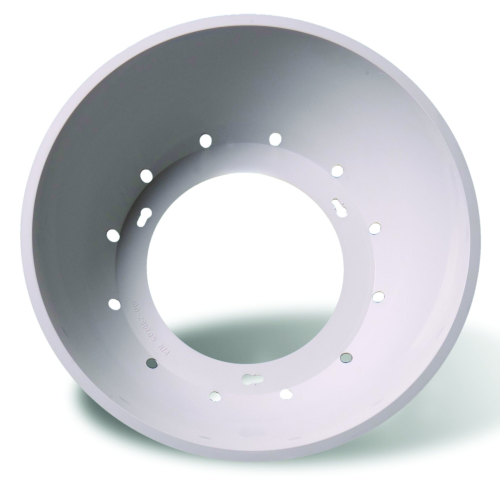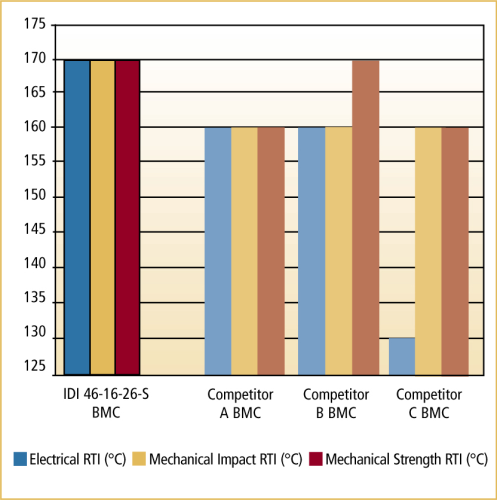


To produce parts that provide high performance at high temperatures, many design engineers are switching from metals to thermoset composite materials, which are known for their ability to take the heat in a variety of demanding applications. Now, however, a special grade of bulk molding compound (BMC) has leapt ahead of its composite competitors with a highest-ever temperature rating in the thermoset polyester composites industry from Underwriters Laboratories (UL).
Produced by IDI Composites International, a leading formulator and manufacturer of thermoset moulding compounds, 46-16-26-S BMC recently received a Relative Temperature Index (RTI) rating of 170ºC, the highest temperature rating ever given by UL to a thermoset composite. RTI ratings are determined by a thermal aging process that measures the retention of critical material properties such as dielectric strength, tensile strength, and impact resistance.
Maintaining critical properties
The RTI rating for 46-16-26-S applies to the electrical and mechanical properties of the material, meaning that the material retains both its high strength (tensile, flexural, and compressive strength of 10 000 psi, 20 000 psi, and 26,000 psi, respectively) and excellent insulative capabilities (dielectric strength of 400 kilovolts [kV] per inch) when exposed to high temperatures. In the past, some composites have received high ratings for electrical or mechanical properties, but not both. Therefore, engineers using these materials must design for the lower rather than the higher of the two temperature ratings.
Prior to issuing its 170ºC rating for 46-16-26-S, UL had only gone as high as 160ºC in its ratings of composite materials. Though the two ratings may seem close, the higher rating actually represents a dramatic step forward that makes 46-16-26-S much better suited than its nearest competitors for high-temperature applications, lasting years or even decades.
Of particular importance to product designers, the material’s high UL rating reduces or eliminates the need for troublesome temperature testing of components during product development. This testing can be extremely expensive and delay product introduction for years.
Since colours other than black can have a significant impact on material properties, the original UL approval for 46-16-26-S was only for black versions of the material at the V-0 flame level, the minimum required for most electrical applications. More recently, however, the material has been approved at the 5VA flame level, the top UL level for high-temperature materials. In addition, the approval is for all colours of the material at a minimum thickness of 3 mm. With this approval, which is extremely difficult to obtain, the material is now suitable for the many products that require a high flame rating as well as moulded-in colour for identification or cosmetic reasons. This means that designers can specify 46-16-26-S in any colour needed for an application and be confident that their product will meet high-heat requirements, but will not have to undergo a long and costly testing process to prove it.
High-heat applications
Able to take the heat for lengthy periods of time, 46-16-26-S can replace metals in the transformers that sit on top of telephone poles. Exposed to the sun all day, these transformers operate at high temperatures over their decades-long life span. In addition to the transformers themselves, 46-16-26-S is used to make many different parts that are located near transformers and other hot objects. Common applications include power-distribution switchgear and circuit breakers, as well as motor- and generator-insulation components such as supports and outer casings.
In the lighting market, 46-16-26-S can be used for components of large lights in outdoor parking lots. These parts, which include transformers, reflectors and terminal strips, are exposed to high temperatures while the lights are on at night. The composite is also suitable for outer light housings, which require heat-resistant properties because they are in close proximity to hot internal components.
Other possible markets and uses for 46-16-26-S BMC include:
- HVAC (heading, ventilation and air conditioning): to replace sheet metal parts in or near burners;
- appliance: for components exposed to heat in household and commercial kitchens;
- alternate energy: in the hot parts of devices such as fuel cells; and
- automotive/heavy truck: heat shields and exhaust-system components.
BMC background
BMC is one of the major types of thermoset composite materials. Composites consist of fibre reinforcement in a polymer resin. The fibre provides strength and stiffness, while the resin protects the fibres and gives the material its shape.
Composite resins change from liquids to solids during the moulding process. Exposure to thermal energy causes the formation of three-dimensional covalent bonds between the molecules. This process, known as crosslinking, is irreversible. Since crosslinking permanently solidifies the materials, they are known as thermosets.
Crosslinking creates a rigid molecular structure that allows thermosets to maintain good physical and electrical properties during prolonged exposure to high temperatures. This characteristic distinguishes thermosets from thermoplastics, which are generally unsuitable for high-temperature environments because they can be melted again after solidification.
For BMC materials, plastic resin, fibre reinforcement, and several other ingredients are blended to form a viscous, putty-like material. By weight, BMC normally includes 5-25% reinforcement, which typically consists of short chopped-strand glass fibres. BMC formulations are suitable for compression, transfer and injection moulding.
Other advantages
In addition to meeting high-temperature requirements in a wide variety of applications, 46-16-26-S offers all the other benefits of BMC materials:
- design freedom: composite moulding processes allow the creation of complex shapes and intricate details that are impractical or even impossible to produce when using metal-shaping techniques.
- no machining: unlike metals, BMC can be moulded into complex parts in a single step, which shortens production time;
- moulded-in colour: using BMC eliminates the need to paint components in desired colours;
- light weight: thanks to BMC’s high strength-to-weight ratio, components made of this material are up to 35% lighter than steel parts of equal strength;
- corrosion resistance: unlike metals, BMC provides excellent corrosion resistance, which allows it to withstand extended exposure to the elements and corrosive substances; and
- low cost: BMC costs less than metal alternatives and requires little or no maintenance, even in harsh environments.
Advantages over metals
A highest-ever temperature rating from UL proves that 46-16-26-S BMC can effectively replace metals in some of the hottest environments. The composite’s subsequent all-colour approval also ensures that it can meet important appearance requirements for many applications. 46-16-26-S also offers all the other benefits of BMC, including exceptional strength and stability, light weight, corrosion resistance, and low cost. With its ability to take the heat and its numerous advantages over metals, 46-16-26-S should continue to win converts among designers and manufacturers for a variety of high-performance applications.





